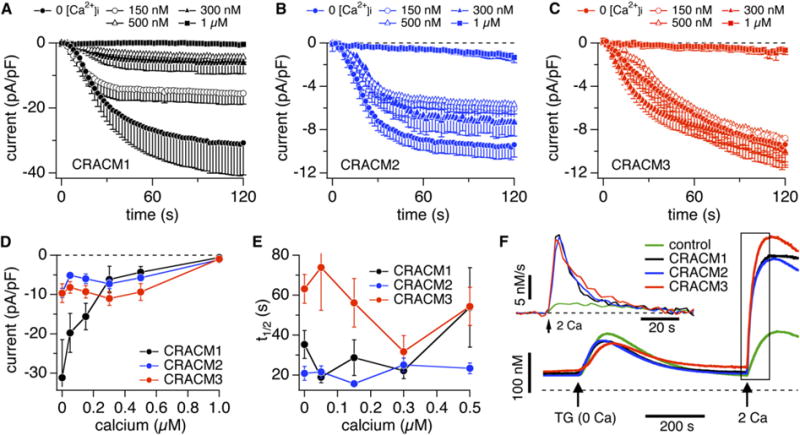Figure 3.

CRACM1, but Not CRACM2 or CRACM3, Is Inhibited by Increased [Ca2+]i
(A) Average CRAC-current densities at −80 mV induced by IP3 (20 μM) in stable STIM1-expressing HEK293 cells transiently overexpressing CRACM1 and perfused with increasing [Ca2+]i (n = 5–12). Error bars indicate SEM.
(B) Experimental protocol as described in (A), but for CRACM2-expressing cells (n = 5–8). Error bars indicate SEM.
(C) Experimental protocol as described in (A), but for CRACM3-expressing cells (n = 9–15). Error bars indicate SEM.
(D) Average current densities of CRACM1 (black), CRACM2 (blue), and CRACM3 (red) at −80 mV extracted at 120 s (150 s for CRACM3) from the cells shown in (A)–(C) and plotted versus [Ca2+]i. Error bars indicate SEM.
(E) Half-maximal activation time of CRACM1 (black, n = 5–12), CRACM2 (blue, n = 5–8), and CRACM3 (red, n = 9–15) plotted versus [Ca2+]i. Data were derived from the cells shown in (A)–(C). All cells had similar series resistances in the range of 4–6 MU. Error bars indicate SEM.
(F) Average changes in [Ca2+]i induced by store depletion in stable STIM1-expressing HEK293 cells transfected with empty vector (green, n = 14), or transiently overexpressing CRACM1 (black, n = 23), CRACM2 (blue, n = 39), or CRACM3 (red, n = 27). The arrows indicate application of thapsigargin (2 μM) in Ca2+-free solution to induce store depletion and readmission of 2 mM Ca2+ to probe Ca2+ entry. The inset represents rates of [Ca2+]i obtained by differentiating the trace segment enclosed by the rectangle.
